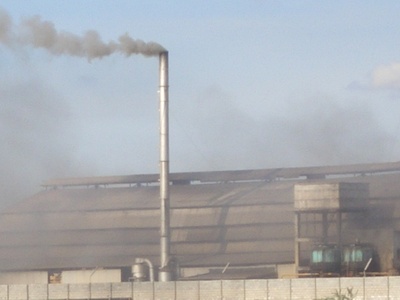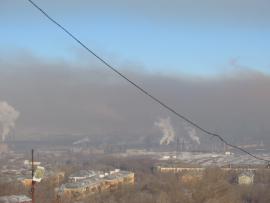Urban Air Quality
Description
Airborne pollutants can be classified broadly into two categories: primary and secondary. Primary pollutants are those that are emitted into the atmosphere by sources such as fossil fuel combustion from power plants, vehicle engines and industrial production, by combustion of biomass for agricultural or land-clearing purposes, and by natural processes such as windblown dust, volcanic activity and biologic respiration. Secondary pollutants are formed within the atmosphere when primary pollutants react with sunlight, oxygen, water and other chemicals present in the air.
Both primary and secondary pollutants may consist of chemical compounds in solid, liquid or vapor phases. Outdoor air pollution in the context of public health is characterized by several major airborne pollutants. Particulate Matter (PM), Tropospheric Ozone (O3), Nitrogen Dioxide (NO2), and Sulfur Dioxide (SO2) are some of the most commonly monitored pollutants. Particulate matter in the atmosphere is mainly attributed to the combustion of fossil fuels, especially coal and diesel fuel, and is composed of tiny particles of solids and liquids including ash, carbon soot, mineral salts and oxides, heavy metals such as lead, and other organic compounds1. Particulate Matter is typically measured and characterized by particle size, as either PM10 (particle diameter ≤ 10 microns) or as PM2.5 (particle diameter ≤ 2.5 microns). The smaller particles are able to penetrate deeper into the lungs, disrupting the exchange of oxygen into the blood and causing inflammation. NO2 and SO2 are chemicals produced by the combustion of fossil fuels and play a major role in generating photochemical smog, as well as creating acid rain. Ozone is a major component of photochemical smog, an air pollution phenomenon that forms when primary pollutants like NO2 and Carbon Monoxide (CO) react with sunlight to form a variety of secondary pollutants. Another important pollutant is lead (Pb) in countries where leaded gasoline is still in use. This can be a significant contribution to airborne pollution. Lead exposure poses serious health risks to any population, but children especially are at risk of significant neurological and developmental damage from prolonged exposure.
Context
Outdoor air pollution and photochemical smog can occur in any environment where there are large and continuous emissions of primary air pollutants. However specifics of climate and geography play an important role in the persistence and severity of the pollution. In warm and sunny climates, air in the upper atmosphere can become warm enough to inhibit vertical air circulation and the dispersion of air pollutants, trapping smog in the lower atmosphere.
Urban areas in topographic basins or valleys where surrounding hills or mountains inhibit air circulation are also prone to the build-up of persistent and high levels of photochemical smog. The health impacts caused by outdoor air pollution have been widely recognized by both national governments and multilateral development organizations as a threat to urban populations, especially in developing countries. The WHO estimates that 865,000 deaths per year worldwide can be directly attributed to outdoor air pollution.2 Most studies on the health effects of outdoor air pollution have focused on urban environments (>100,000 people) where the impact is considered to be most severe. People living in large urban areas, especially in developing countries, where the health risks of air pollution may be underappreciated and pollution controls lacking, are routinely exposed to concentrations of airborne pollutants that have been shown to cause negative health effects in both the short and long term.
Exposure Pathways
People are exposed to outdoor air pollution by breathing in pollutants, and by exposing eyes and skin while they are outdoors. Exposure is intensified by vigorous activity, as pollutants are drawn more deeply into the lungs during periods of physical exertion. People who live or work in close proximity to emission sources such as power plants, local industry or highways/major roadways are often exposed to higher concentrations of pollutants for longer periods of time, which elevates their risk of developing acute and/or chronic health problems. Long-term exposure to relatively low levels of pollutants can also cause serious health problems. Cities in developing countries often suffer heavily from outdoor air pollution, due to the heavy use of diesel fuel for transport vehicles, the predominance of coal for power generation, the proximity of urban populations to industrial facilities, and the lack of advanced emission controls for vehicles and industry.
Health Effects
Major health effects associated with outdoor air pollution are typically associated with chronic pulmonary and cardio-vascular stress from the fine particles and include increased mortality, respiratory and cardiovascular disease, lung cancer, asthma exacerbation, acute and chronic bronchitis, restrictions in activity and lost days of work. The health effects of outdoor air pollution fall disproportionately on infants, children and the elderly.
People with pre-existing health conditions are also significantly affected. Studies indicate that chronic exposure to NO2 may impair lung development in children and cause structural changes in the lungs of adults. Exposure to ground-level ozone also causes burning and irritation of the eyes, nose and throat, and the drying out of mucous membranes, reducing the ability of the body to resist respiratory infections. Overall, health effects depend on many factors: the pollutant and its concentration in the air, the presence of multiple pollutants, temperature and humidity conditions, and the exposure period of a person to the pollutant, in both the short- and long-term.
What is Being Done
Although much progress has been made on reducing outdoor air pollution in developed countries, many cities in the these countries still frequently exhibit levels of pollutants that exceed recommended limits. The situation in developing countries is considerably worse. While the development of the catalytic converter for automobiles, the introduction of low-sulfur gasoline, and tough regulatory standards for tailpipe and power plant emissions have significantly reduced the emission of PM, NO2, and SO2 from fossil fuel combustion in developed countries, all of these changes required capital investments that many developing nations are not capable of making. For many cities in the developing world outdoor air pollution seems a monumental challenge, as there are few “quick fixes” and the costs of introducing advanced pollution control technologies can be steep.
Outdoor air pollution is a complex and multifaceted problem that requires an integrated approach to solving. Collaboration between urban planners, transportation engineers, energy and environmental policy makers and economists is critical to developing solutions that reduce air pollution and its health impacts. Bangkok, Thailand is an excellent case study. Faced with rapid growth and urbanization in the 1990s, outdoor air pollution in Bangkok quickly rose to dangerously high levels. A multi-pronged strategy was instituted to combat the problem, including the introduction of emission reduction regulations, the elimination of leaded gasoline and the introduction of catalytic converters. In addition, other simple and cost-effective actions were taken: paving of road shoulders to reduce dust, public education and provision of free engine tune-ups. On a longer time-line, the city set to developing and expanding its mass transit systems. As a result of this integrated approach, Bangkok now has air quality that is better than American standards, and is approaching those of the E.U.
The phase-out of leaded gasoline is an important step, as it not only reduces the health impact of lead poisoning on the population, but also is necessary for the introduction of catalytic converters, which require unleaded fuel. Blacksmith Institute has conducted two successful projects to monitor and assist in the phase out of leaded gasoline in Senegal and in Tanzania. Reducing the sulfur content of diesel fuels is also an important step in combating air pollution. Lowering sulfur dioxide emissions reduces both the health impacts of outdoor air pollution and the environmental and agricultural damage caused by acid rain. Reducing the sulfur content of diesel also permits the use of more advanced pollution controls systems that can further reduce PM and NO2 emissions. In many Asian cities, diesel vehicles are both the fastest growing segment of transportation and one of the largest contributors to outdoor air pollution. A measured and responsibly paced reduction of sulfur content in diesel fuels sold in these cities would provide significant benefits to the health of their populations.
Footnotes
1 “Research Areas: Hazardous Components” Research Programs: Particulate Matter (PM) Health Effects. Environmental Protection Agency. Last Updated May 2, 2008. Available at http://www.
epa.gov/NHEERL/research/pm/research_area05.html
2 Ostro, B. “Outdoor air pollution: assessing the environmental burden of disease at national and local levels.” World Health Organization. 2004. Available at http://www.who.int/quantifying_ehimpacts/publications/ebd5/en/index.html
3 “World Development Indicators 2007”, World Bank. 2007. Available at
siteresources.worldbank.org/DATASTATISTICS/Resources/table3_13.pdf
Additional Resources
Urban Air Quality (word doc)
Additional Photos
| Skyline demonstrating the extent of urban air pollution. Magnitogorosk, Russia. Photo by Blacksmith Institute. | |
 |
Hyderabad, Andhra Pradesh India. Photo by Blacksmith Institute. |
|
Howrah Calcutta, India. Photo by Blacksmith Institute. |




